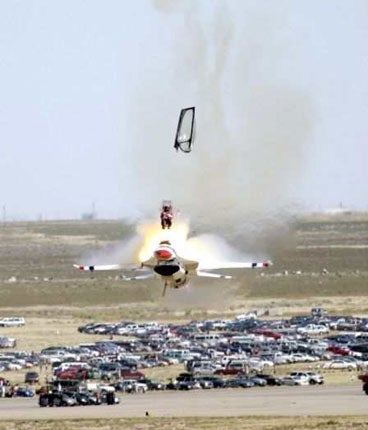The club where you have to get thrown out to be allowed in
Want to join the Ejection Tie Club? Then all you have to do is pull a handle ...

There are some clubs that are nigh on impossible to get in to: but surely few can claim to be quite as selective about membership as the Ejection Tie Club. To become part of this truly elite association one has to have been fired out of a military plane by ejection seat.
Established after the Second World War, the club has 5,607 members worldwide, approximately a fifth of whom are British. The first pilot to be accepted was a RAF serviceman who ejected over what was then Rhodesia in January 1957. The latest to apply is a Pakistani who was forced to abandon his plane just last month. Details of their members, explained club secretary Eric Thomas, are closely guarded as many are still serving in the military.
To date only 10 women have successfully applied to join the Ejection Tie Club, the first of which was Lieutenant Linda Maloney, a former American naval aviator and mother of two boys who ejected from an A-6 Intruder in 1991. Ms Maloney, who retired from the forces four years ago, recalled that during the flight one of the hydraulic lights came on, indicating failure. The plane was at 15,000ft when it started to slowly roll to the right. The senior pilot could not steady it and ordered: "I don't have control, eject."
"At that point I pulled the lower ejection handle and my seat exploded through the canopy glass," Ms Maloney said. "My pilot ejected seconds later. I lost consciousness briefly and when I came to, I was hanging in my parachute heading towards the ocean." Both she and the pilot had minor injures but were flying again within weeks.
Every club member is given a tie and pin, or a brooch for the women, which depicts a red triangle, the recognised international danger symbol for an ejection seat. The organisation was set up by Martin Baker, the leading manufacturer of ejection seats. Mr Thomas said: "The reason for the tie was that, when they weren't in uniform, they would have some form of recognition among themselves that they had ejected in a Martin Baker seat in order to save their lives."
While the members are all invited as honoured guests to the company's hospitality tents at air shows, little more fuss is made of the self-effacing group. "Some of them get together in their own little groups. The Belgians for example have their own group of ejectees but they network among themselves," said Mr Thomas.
Emergency ejections have been made under conditions ranging from ground level to the highest at 57,000ft. The company's first success came on 20 May 1949 when test pilot Joe Lancaster bailed out of an AW52 research aircraft. In June 2003 Martin Baker announced that its seats had saved a 7,000th life after Lieutenant Commander Robert Schwab of the Royal Navy had to eject from a Sea Harrier at 10,000ft off the coast of Devon.
It was in fact his second ejection; he had to bail out of a Hawk trainer in 1984 after its landing gear collapsed.
*There was absolute silence in the cockpit of the Hawker Hunter as test pilot Rhys Williams realised they were not going to make it. Engine problems meant he was going to overshoot a runway as he brought the plane in so the RAF Squadron Leader turned to his navigator and told him to eject. "The good thing is he didn't ask questions. He just pulled his handle. As soon as I saw his seat lift I pulled my handle," explained the pilot. "Time just stands still and it seems like an age then you are off. The temptation is to look down but you must not do it or you will damage your neck. You have to stay tense and in position. I almost exploded out of the aircraft. It is a fearsome punch as you go out. It is just like someone crashing into you. You just brace and stiffen all your muscles. You are not breathing." Mr Williams, 51, who now works for QinetiQ and as a tutor at the Empire Test Pilots School in Wiltshire, broke both his legs. His navigator had spinal injuries. Both recovered and Mr Williams is adamant he would not hesitate to pull the handle again. "It has absolutely nothing to do with bravery, it is simply a survival instinct and your training."
Join our commenting forum
Join thought-provoking conversations, follow other Independent readers and see their replies
Comments